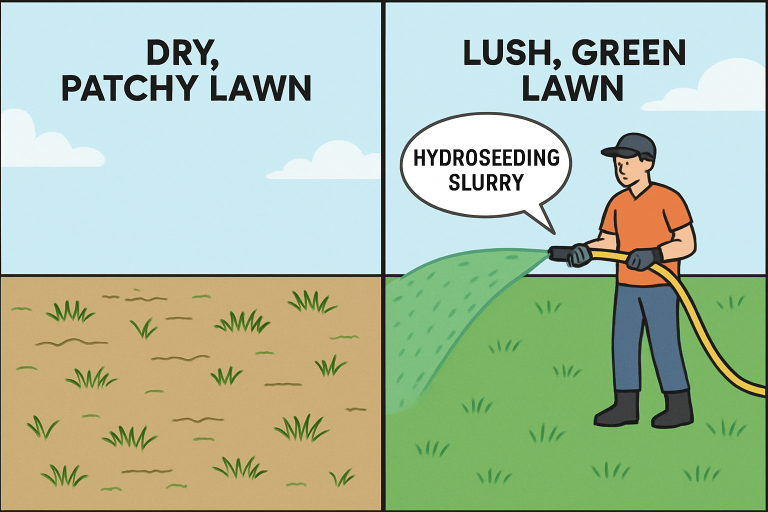What Is Hydroseeding?
Hydroseeding is an innovative lawn installation process that involves spraying a homogenous mixture of grass seed, fertilizer, mulch, and water over prepared soil. This method is highly effective in quickly establishing healthy, resilient grass across various property types. For those considering large-scale or high-visibility turf projects, understanding factors such as hydroseeding cost Southern California is essential for budget planning and achieving optimal results.
Unlike traditional methods that may require separately applying seed and fertilizer, hydroseeding delivers everything in a single pass, ensuring a uniform application. This method adapts well to the diverse climates and landscapes in residential and commercial settings, reducing labor and accelerating transformation times for dull, patchy lawns.
How Does Hydroseeding Work?
Hydroseeding starts with thoroughly mixing inside a specialized tank, combining chosen seed varieties with water, nutrient-rich fertilizers, and protective mulch fibers. This slurry is sprayed via hose or boom over the prepared area, ensuring even coverage and consistent seed placement. The mulch layer not only supports germination by retaining soil moisture but also shields the seeds from wind, runoff, and pests, giving hydroseeding a clear technical advantage for soil stabilization.
Advantages of Choosing Hydroseeding
- Faster Germination and Growth: Under ideal conditions, most grass seeds will sprout in as little as 7–10 days and establish visible greening within weeks.
- Superior Coverage: Hydroseeding’s mixed slurry adheres well to slopes, uneven terrain, and large properties—minimizing bare spots and patchy results.
- Cost-Effective: Hydroseeding proves more affordable than sod, especially on large areas, while saving time versus hand seeding. Thorough research or consultation about optimal grass seed planting times can further enhance the return on your investment.
- Eco-Friendly: The mulch retains precious soil moisture, helps minimize water runoff, and reduces the overall need for chemical applications.
- Customizable: The seed mix can be tailored to climate, soil type, and specific usage requirements to strengthen lawn resilience in the long term.
Site Preparation and Best Practices
Success with hydroseeding starts long before the first drop of slurry hits the ground. The area should be cleared of debris, rocks, or persistent weed growth, followed by loosening the soil to enhance drainage and allow robust root development. Slightly grading the lawn and ensuring smooth contours will help prevent water pooling and ensure an even lawn surface.
Professionals recommend conducting a soil test to determine nutrient needs and pH balance so fertilizers can be selected accordingly. For most regions, seeding in spring or early fall produces the best outcome because of milder temperatures and consistent precipitation, giving young grass the ideal start it needs.

Aftercare Tips for Healthy Growth
Diligent care in the weeks following hydroseeding is critical to establishing a vigorous, healthy lawn. The soil must remain consistently moist for at least the first few weeks after application—watering lightly two to three times daily facilitates rapid germination and root establishment.
Homeowners should avoid walking on or mowing the tender shoots until the grass is about three inches tall. Use the mower’s highest setting at that time to avoid stressing young grass. Eventually, watering frequency can be decreased while increasing depth, fostering drought tolerance and deeper root systems for lasting health.
Comparing Hydroseeding to Traditional Methods
When it comes to new lawn installations, hydroseeding sits between sodding and conventional hand seeding in terms of speed, cost, and long-term results. Sod may provide instant greenery but carries a steep price and requires consistent aftercare, particularly in hot, dry climates. Hand seeding, though affordable, is prone to uneven coverage and is slower to establish. Hydroseeding’s slurry ensures even seed distribution, better resistance to erosion, and lower overall cost for substantial lawn areas—making it the preferred choice for parks, roadways, and even private lawns looking for a high-quality finish.
Scientific Advances and Sustainability
Hydroseeding has kept pace with a growing demand for eco-friendly landscaping. Technological improvements such as biodegradable mulches and polymer-based tackifiers make it easier to maintain soil moisture and promote seed survival in harsh climates. Research in major publications supports the use of vegetated groundcover for curbing runoff and enhancing local biodiversity, with hydroseeding now central to this sustainable shift. In many cases, these innovations have proven to reduce overall water usage and limit the need for chemical interventions, benefiting both the environment and property owners.
Real-Life Outcomes: Success Stories
Across the country, commercial projects, athletic fields, and homeowners all report significant improvements after transitioning to hydroseeding. After construction work, municipalities struggling with rapid soil erosion have found that hydroseeding swiftly restores green cover and reduces runoff issues. Homeowners regularly share before-and-after stories where barren or uneven yards were transformed into lush, consistent greenery in only a few weeks, reinforcing the method’s reliability for various project sizes and soil types.
Modern hydroseeding combines science, sustainability, and efficiency to create healthier, more resilient lawns with less effort. Improving seed-to-soil contact, conserving water, and reducing erosion offer an eco-friendly alternative to traditional methods. This approach empowers homeowners and landscapers to achieve vibrant, lasting landscapes while supporting environmental stewardship.
Visit our Blog for more Updates


